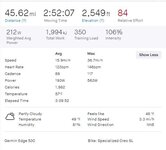Sunshine2021
Member
- Region
- Europe
Hi
being new in the ebike world I want to overcome my range anxiety. I know I can tune the battery usage using support and peak power in the Mission Control app . I read the documentation but still don‘t understand how to figure out the best setting. I am aware that the settings strongly depend on your personal likings but are there any general rule of thumbs ( e.g. lower peak power to < 100%) to get the most out of the battery ?
(Of course I could aways use Smart Control instead If I know my tour beforehand … . )
)
Thanks!
being new in the ebike world I want to overcome my range anxiety. I know I can tune the battery usage using support and peak power in the Mission Control app . I read the documentation but still don‘t understand how to figure out the best setting. I am aware that the settings strongly depend on your personal likings but are there any general rule of thumbs ( e.g. lower peak power to < 100%) to get the most out of the battery ?
(Of course I could aways use Smart Control instead If I know my tour beforehand … .
Thanks!
